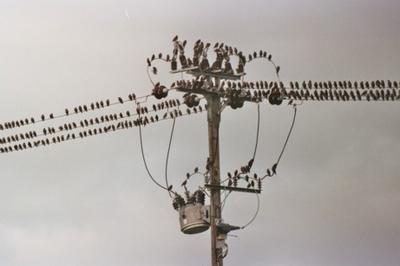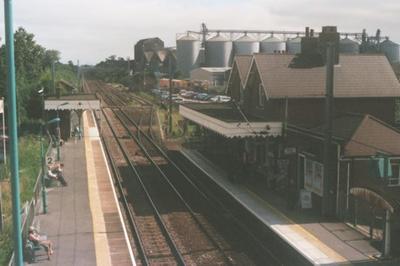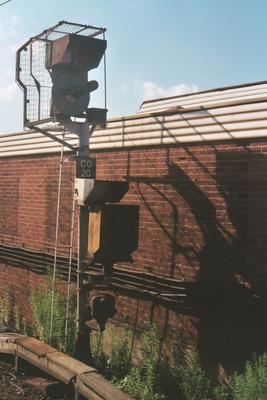The Beast of Scole
I went for a morning walk while the boys slept. We were scheduled to take the train to Colchester at 10, but there seemed to be plenty of time. En route I picked up some apple sausages and pork burgers at the town butcher: it's best to get your groceries early, before they're all sold! Following the cool hand-drawn area map I'd purchased in Diss, I located the trailhead at Park Road beyond the river. My aim was to follow the footpaths on the map to yet another bridge and then loop back to town. The path was there but was simply tamped-down grass bordered with the requisite nettles. Nonetheless I proceeded. A lot of wildlife was about in the still morning: Canada geese, rabbits, and a huge number of birs (starlings?) on the telephone wires -- not counting livestock.

After awhile not only did the promised bridge not materialize but I found that the path was not following the configuration the map showed. I sort of crawled under some barbwire (still following the path, mind you) into a field of huge cows, who began slowly but determinedly approaching me. I hastened on to the next stile and found myself in a field of wheat, or something like it -- the footpath was literally just a slash through the crop; at one point two such paths met to form a cross in the middle of the vast field.

Meanwhile thoughts of the Beast of Scole crossed my mind. (One of the first things I'd read in the local newspaper, while awating our first night's Chinese take-away, was that a local woman had spotted what appeared to be a large black panther crossing a field near her home in Scole. I later checked the map: Scole was about three miles up the road! This beast seemed to have been following me -- there have been, over the years, reports of a similar creature in other places we've visited, such as Evesham and the Forest of Dean.) No one knew where I was this morning. I was glad I at least had a bag of sausage I could distract the panther with, unless I had to eat it myself first to stave off starvation.
It being the point of no return timewise, I continued on, finally finding an actual footpath marker on a fence post, and I followed more of these to a "lane " (a tractor path) which finally arrived at a paved road. Both the lane and road could be construed to be those portrayed on the map, but how I could have arrived there was suspicious. At any rate I flagged down a car. "Excuse me," I said, "I seem to following a somewhat flawed map. Could you please tell me where I am on it?"
Sure enough, I had gone far south and west from where I was trying to go or thought I was going. I was nearly to Yaxley. Fortunately it was a clear, if lengthy, way back to Eye, so I started up the road at a speed-walker's pace. It was now about 8.40 and I'd hoped to be back at the cottage by 9. This I amazingly enough managed, give or take a couple of minutes, even with my stopping for some eggs ("Help Yourself!") at a little hutch outside a farmhouse. They were so fresh they still had grass sticking to them.
Back to Boudica
We made it on time to the electric commuter train at the Diss station -- the parking lot was overflowing.

We had a picturesque hour's ride south through fields and past estuaries to the city of Colchester, where we were met by poet Estill Pollock, with whom I'd corresponded after reading a book of his and accepting several pieces for Fine Madness magazine. A tall American who's lived in England 25 years or so, he drove us through the roundabouts and to his home island on the edge of the North Sea, West Mersea, population surprisingly 7000. We walked along the road beside the seafront, past many old liveaboard boats of all sizes, on blocks in the sandflats, which at high tide you accessed via rickety wooden walkways; the tide was quite far out at the moment. The island itself, in fact, is only accessible when the tide is not high -- otherwise the causeway road itself can be under as much as a couple of feet of water and you must queue up and wait for the tide to turn in order to enter or leave. Estill always carries a tide table.

We took in the lovely old black-and-white houses and the working waterfront -- fishing boats, seafood stands, and chandlers, etc., descended the "Monkey Steps" to check out "St. Peter's Well," of ancient origin, just steps from the sea, and spent some time on the beach itself. After dropping by his house briefly, we drove to The Peldon Rose pub for a fine meal outside by a pond. Skate, tuna, cod, and Guinness! We chatted about publishing, poetry, and weirdly the recent reports of a black panther around Colchester.
Then back into the city for a tour through Colchester Castle, basically an empty shell like Clifford's Tower, only larger, which has been reconstructed inside to accommodate a quite good museum featuring items from Colchester's Roman and pre-Roman past. Especially mind-blowing were burnt plum pits dating from the destruction of the Roman temple by the forces of Boudica (Boadicea) which took place on the site of the castle two thousand years ago (30,000 Romans were killed).

After a short walk in the gardens behind the castle and through St. Botolph's, a ruined priory where the local drunks now like to spend the night, Estill returned us to the train station. We spent the whole trip standing in the breezeway between cars as the air conditioning in the carriages was not working.




No comments:
Post a Comment